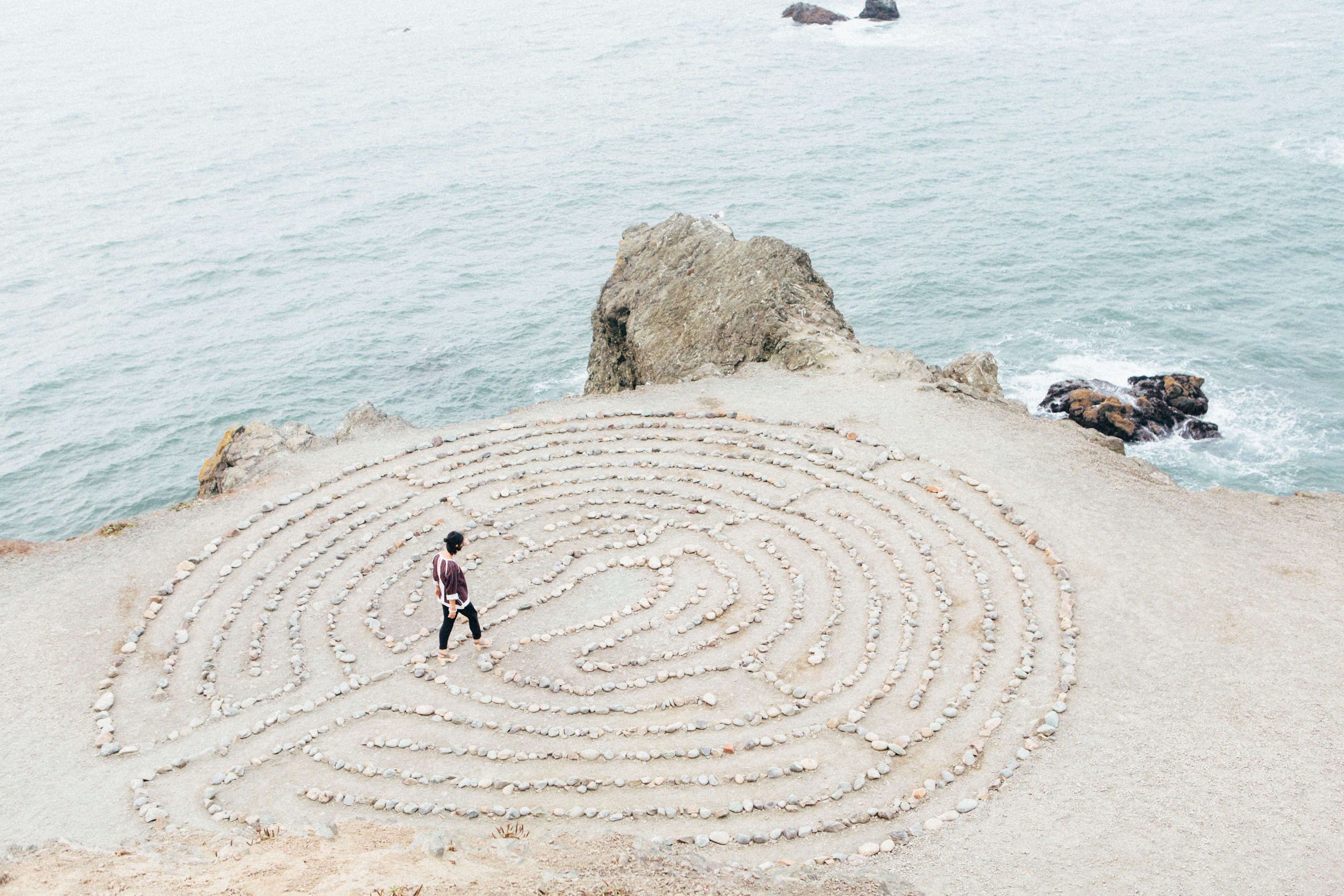Mindfulness in America is both fashionable and perplexing. With endless apps, gurus, and books on the topic, starting a mindfulness practice isn’t so simple.
You can find mindfulness products for just about everything—stress reduction, sleep, performance, even mindfulness for dogs (I’m not kidding!)–but how do you know what is best for you?
If you’re thinking of starting a mindfulness practice, you need to ask the right questions. Unfortunately, the most obvious questions aren’t necessarily the most helpful. For example:
- What practices are best?
- How long should I practice?
- What time of day is best to practice?
- Do I need to be in a certain posture?
All these miss a major piece of the mindfulness picture—YOU!
Rather than worrying about how to practice, start with why you are interested:
- Why is mindfulness important to you?
- How will these practices impact your unique body and mind?
- What kind of commitment are you ready to make?
The difference between people who practice mindfulness regularly and those who dabble and drop-out depends on answering these questions.
Self-inquiry is the fuel required for starting a mindfulness practice that actually lasts.
Question 1. Why Are You Starting A Mindfulness Practice Now?
It is shortsighted to begin any mindfulness book, app, or class until you’re clear why you’re getting started.
- Why are you motivated to practice now?
- What has happened or changed that has made this a priority for you?
Examine your deeper motivation and ask,
“Is this important enough to get me to pause and practice, even when life is pulling me in a million different directions?”
From my experience teaching and practicing mindfulness, there are generally two things that fuel people’s motivation: A push and a pull
The Push:
- Something happened in your life that shook you at the core. Mindfulness appeared on your radar, not as a nice luxury, but as a necessity for better understanding yourself.
- Pain, trauma, or anxiety led to you mindfulness as a tool for working with and building your capacity to handle uncomfortable feelings and challenging emotions.
- Years of reenacting the same patterns have harmed yourself and your relationships. You’ve found mindfulness a way to reprogram your mind, soften your jagged edges, and rebuild your relationships.
- The drain of living in a non-stop, hyper-stimulating world nearly drove you crazy. Mindfulness became a means to stay grounded and in touch with your inner quiet and peace.
The Pull:
- The allure of altered states or enlightenment led you to mindfulness as a doorway for practices that can supercharge your consciousness.
- You have read books or listened to friends discuss the benefits of mindfulness. You are drawn to the potential benefits such as greater tranquility, focus, and peacefulness in your life.
- You want to learn to better focus your attention on what really matters and Mindfulness seems like a way to be intentional and productive with your time.
- All the cool people are starting a mindfulness practice, so why not give it a try 😉
Whatever your push and pull may be, it is necessary to ask what has changed over the last few months that has made you ready for action now. If it’s not immediately apparent why you are starting a mindfulness practice, simply keep the question close to heart and listen for your truth.
Understanding your own motivation and drive to practice mindfulness will make you more likely to follow through and help you avoid these common pitfalls:
- Falling prey to opportunistic marketing strategies that feed off your insecurities. If you’re aren’t sure why you want to practice, it’s easy to feel like you need to buy every mindfulness book, bell, and recording available to fill a perceived lack of knowledge or trust in yourself.
- Losing motivation to practice because you haven’t fully articulated why this is important to you (and to those around you). A clear motivation will keep you in the game even when it is easier to be on the sideline.
- Thinking you no longer need to practice because your initial “push” or “pull” has lessened. The benefits of mindfulness don’t go away simply because you’re in a better place. These practices evolve with you, always leaving more to uncover if you’re willing.
Mindfulness Discussion Questions To Discover Your “Why” :
- I need to be more mindful because… (the push)
- I want to be more mindful because… (the pull)
- I am ready to practice mindfulness now (as opposed to 6 months ago) because…
Question 2. Are You Committed To Formally Learning A Mindfulness Practice?
Take a moment and ask yourself which of these two camps is most true for you:
I’m curious about mindfulness, but mostly in an informal way. I’m interested in short practices that I can insert into my day. I don’t have the time, resources, or willingness to practice daily or take a class.
Or…
I’m really interested in learning and developing a formal mindfulness practice that includes sitting meditation. I want to practice consistently every day. I feel ready, willing, and able to dive in and take a class to learn how to do this properly.
This distinction might seem silly at this point, because if you’ve never experienced a mindfulness practice, you probably don’t know how committed you’ll feel.
However, the distinction will impact your approach and where it’s best to start your mindfulness journey.
An informal approach to practice tends to be less planned and less intense. Maybe this involves using a guided meditation on an app every now and then. Or maybe it means reading about a book and trying an exercise you learned.
This approach frames mindfulness as a luxury rather than a necessity. It uses mindful awareness practices as tools for dealing with daily challenges. You may not need to use the tool daily, but when the opportunity arises, you have some ideas of how to apply what you’ve learned.
A formal approach, on the other hand, entails a formal commitment to practice, regardless of how you feel or if you think you need it.
This usually entails longer meditations done with your eyes closed. It also means signing up for a class or program to learn about mindfulness in a structured way.
Let Your Level Of Commitment Guide Your Practice
There isn’t necessarily a right place to start. There is simply what is best for you right now. Don’t feel bad if you’re not to ready commit to a daily practice. It’s ok to experiment with mindfulness in informal ways without immersing yourself in a class.
Just know that in order to strengthen your mindfulness muscle, longer and more deliberate practice is key. If you only practice occasionally in a haphazard manner, you will never strengthen the underlying mechanisms to drop in more often.
This is the real value of a more formal approach to starting a mindfulness practice–it gives you a community, curriculum, and teacher to ask questions and reflect on your experience. A skilled instructor or coach can give you personalized instruction and adjust practices to meet you where you are at in your journey.
One Important Consideration: Commitment > Motivation
Does your level of commitment serve your deeper motivation you listed in question #1?
Connecting your motivation to the reality of your life right now and your degree of interest will inform what level of practice is right for you. Be honest with yourself about what you are willing to do on a daily basis.
Ask yourself, “Do I need the support of a community to help you with my push or pull, or do I feel comfortable learning on my own?”
However, don’t fall into the trap of thinking you can do it all on your own. In the beginning, motivation is high and it seems easy. The problem is that motivation waivers. Commitment does not. If you don’t make a strong commitment, your practice will likely fizzle out.
The trick is to make your commitment larger than your motivation. This way you set yourself up to stay with the practice, even when you lose some initial momentum. Commitment creates accountability that pulls you down the path regardless of how whether it’s convenient or pleasant to keep marching.
Mindfulness Discussion Questions to Discover Your Commitment & Approach to Learning:
- What else is going on in my life right now that impacts my ability to commit to practicing? Considering these factors, do I have the time and energy for a formal mindfulness class?
- What resources (i.e. books, classes, apps, teachers, etc.) are available and accessible in my area?
- If I am really honest with myself, I am willing to commit ______ of minutes/hours a week to learning and practicing?
- What other activities or practices have I committed to in my life? How can I use lessons from these experiences to help me here?
- The biggest barrier preventing me from committing to a regular mindfulness practice is…
Question 3. Are Your Body, Mind, and Environment Conducive to Practicing Mindfulness? Are There Risks?
Just as it isn’t wise to start an exercise program without considering your health history and medical issues, it isn’t wise to jump into mindfulness meditation without considering the potential risks.
Because mindfulness asks you to stay open and curious about your present experience, it can unearth a lot of stuff—stuff that you may have been unconsciously avoiding precisely because it’s difficult.
It is important to recognize the potential to get overwhelmed when observing the subtleties of your inner physical and emotional world.
Preexisting conditions like pain or anxiety can easily become overbearing when amplified by the power of your attention. This is why it is important to know your own level of activation and how comfortable you feel in your own body.
This is where the context and environment of your practice can make a big difference. If you’re practicing alone or at home, you may feel comfortable but you won’t have any support if you feel triggered or overwhelmed.
On the contrary, if you’re practicing together in a group, it raises questions of trust and safety:
- Do you trust the teacher?
- Do you trust your peers?
- Do you feel safe in the space?
- Do you feel secure enough close your eyes?
No one should assume you can automatically relax and feel comfortable closing your eyes. Establishing safety — both in your own body and in your environment — is the necessary first step to any mindfulness practice.
Without a base of security, it is nearly impossible to turn-off the hyper-vigilant parts of your brain. Your nervous system will remain in a sympathetic dominant state that hinders your ability to widen your attention and access higher-level executive functioning.
Dr. Willoghby Britton at Brown has done excellent research on adverse effects during mindfulness and meditation programs. You can find a toolkit of resources for safely starting a mindfulness practice on the Brown University website.
Certain Mindfulness Practices May Be Triggering For Those Who:
- Are in a troubled place in life. If you are in a difficult life transition such as divorce, imprisonment, or coping with the death of a loved one, recognize that your psyche may be fragile, heart may be heavy, and body may be fatigued. Mindfulness of these strong emotions can be a crucial part of healing and moving on, but be sure you have a supportive environment to come back to.
- Have a history of trauma or abuse. As David Treleaven says in this article, What’s Trauma-Sensitive Mindfulness, “Trauma often lives on inside the body…This is one of the most haunting, visceral costs of trauma: being forced to continually cope with gut-wrenching—often terrifying—sensations.” These traumatic experiences can be reactivated during mindfulness meditation and need to be handled with care. If you know you’re sensitive to particular physical sensations, you can always modify your practice to pay attention to something that feels more secure.
- Have a history of mental illness, psychosis, or dissociation. If you know you have a fragile mind or a family history of mental disorders, mindfulness and meditation can lead you into murky water. Mindfulness practice may untether your sense of self and create unhelpful dissociation between your thoughts, identity, and consciousness. Notice if you’re feeling ungrounded and bring your attention to tangible objects that you can name and hold.
This isn’t to say that you shouldn’t start a mindfulness practice if you’re in a tough place or have had a history of mental challenges. In fact, these practices are powerful ways to build your capacity to stay with your difficulties in a more compassionate way.
The important part is understanding your predisposition to adverse effects and how much you can tolerate unpleasant or disorientating material.
Mindfulness Discussion Questions to Assess Your Readiness and Risk:
- Does this meditation program or recording disclose any potential risks and harm that may arise?
- Are there any modifications or alternative practices that may be more suitable for me?
- Is there support for me to make sense of challenging sensations and feelings that may arise?
- With whom can I ask questions, seek assistance, or debrief after my practice?
- Do I feel safe in the physical environment where I am practicing? Am I willing to close my eyes and be vulnerable?
- Do I have a game plan for how to best take care of myself if I feel triggered?
Start With These Mindfulness Discussion Questions & Follow That Spark Inside
When I first got interested in mindfulness, I was a dabbler. I was uncommitted and would try one type of practice for a bit then jump to another. It took me years to settle into a consistent practice.
Until I really clarified my motivation to stop living on auto-pilot and become a more whole and integrated human (Question #1), I wasn’t able to make mindfulness a staple in my life.
At a certain point, I felt ready to learn and practice mindfulness above and beyond reading about it or trying an app (Question #2). Once I became committed, I really started to feel the impacts of regular practice on my ability to live in a self-directed and connected way.
As I started teaching, I recognized that not every practice is right for every person. It takes tremendous courage to slow down and pay sustained, close attention to your inner world. Moreover, you can only do so if you feel safe. It’s important to find a safe space and community that acknowledges the possibility of adverse effects and creates a container of care that can hold these experiences (Question #3)
Starting a Mindfulness Practice Is a Solo Job. Sustaining One Is a Group Effort.
Mindfulness itself is an ability we all have. Learning to hone this ability is a practice that requires the right mix of instruction, motivation, and dedicated practice. No matter where you find your instruction — with a book, an app, or a class — if you spend time with these questions now, you can save yourself a lot of potential headaches later.
Starting a practice helps you build the inner resources you need to unhook yourself from your experience and reclaim your power to choose where you place your attention.
Ultimately, a dedicated mindfulness practice creates spaciousness in your awareness so you can see that it’s not the content of your experience that really matters, but your relationship to it. This liberates you to define that relationship from a larger and more encompassing lens.
Yet Mindfulness Does Not Have To End There
Being mindful is about seeing yourself and seeing the world more clearly. This means seeing all the love and interconnection AND all the injustice and ignorance. It means being able to stay will all this complexity and contradiction without running away.
To be mindful you must ask:
How can I be right here, right now, safely, and trust what is coming up?
This is a big question and answering it is no small task. The challenge of remaining present through all the crazy and hurtful parts of life requires commitment and support from others.
While you can always start a mindfulness practice on your own, sustaining your practice without a community is hard. We all need reminders to take an intentional pause and welcome every part of who we have been, are, and are becoming … even when it hurts.
To becoming more alive, awake and aware together 🙂
~ Jeff Siegel
I’m Jeff Siegel, a wellness coach and mindfulness teacher, helping people upgrade their habits and improve their health.
Want to learn how to meditate on your own? Sign-up for my FREE 14 Day Meditation Course.
If you’d like to explore working together, you can schedule a private 20-min consultation call with me.




12 Comments